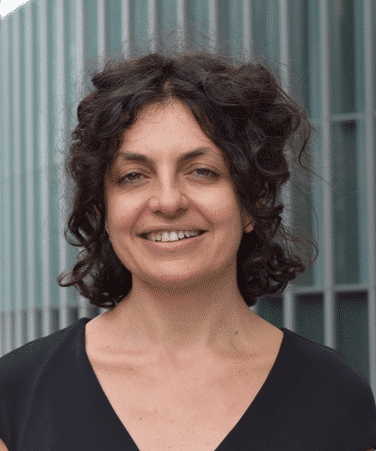Posted on December 15, 2015 in ASRC News, Nanoscience Initiative
A team co-led by Dr. Elisa Riedo, a professor with the CUNY Advanced Science Research Center’s (ASRC) Nanoscience Initiative, recently published a study on nanoscale thermal measurements in Nature Communications.

“Understanding nanoscale heat flow is critical in the design of integrated electronic devices and in the development of materials for thermal insulation and thermoelectric energy recovery,” Riedo said. “While several techniques are currently available to observe heat transport over macroscopic distances, there is a need for new methods capable of revealing the dynamics of heat flow with nanometer resolution and quantitatively.”
Their paper is based on a simple notion: a sharp tip—only a few thousands of atoms wide—attached to a diamond nanocrystal, whose thermally-dependent fluorescence can measure the absolute temperature very precisely.
The sharp tip can be moved around with atomic precision and can measure the temperature of any nanoscale structure researchers want to measure. The researchers were able to use this method to obtain nanometer-resolved thermal conductivity maps as the sharp tip was scanned over various substrates of heterogeneous composition.
In this case the sharp tip was attached to a thermal atomic force microscopy (AFM) cantilever, where the cantilever temperature can be adjusted via the application of an external current. The principle is based on the fact that when a hot probe is in contact with a thermally conductive material—such as a metal—it cools down because heat flows from the probe into the material.
The latter is prevented, however, if the sample material is thermally insulating. This implies that one can infer the sample thermal conductivity by continuously monitoring the tip temperature by means of the diamond nano-thermometer attached to the tip.
“Since joining the ASRC in the summer, Dr. Riedo has formed strong links across CUNY,” said ASRC Nanoscience Initiative Director Dr. Rein V. Ulijn. “Her latest publication—written with Dr. Meriles at City College—shows that these collaborations are already bearing fruit. She has hit the ground running and is making an invaluable contribution to establishing research excellence at ASRC’s Nanoscience Initiative.”
The team anticipates multiple applications, ranging from fundamental problems of heat flow in nanostructures and radiative heat transport in nano-gaps, to the characterization of materials undergoing heterogeneous phase transitions, to the investigation of catalytic exothermal reactions. This form of nanoscale scanning thermometry can play an important role in the characterization of the ‘hot spots’ formed at the junctions of semiconductor heterostructures, known to be critical in the generation of heat within integrated electronic devices.
###
About the ASRC: The CUNY Advanced Science Research Center (ASRC) is a University-wide venture that elevates CUNY’s legacy of scientific research and education through initiatives in five distinctive, but increasingly interconnected disciplines: Nanoscience, Photonics, Structural Biology, Neuroscience and Environmental Sciences. Led by Dr. Gillian Small, Vice Chancellor for Research and the ASRC’s executive director, the center is designed to promote a unique, interdisciplinary research culture. Researchers from each of the initiatives work side by side in the ASRC’s core facilities, sharing equipment that is among the most advanced available. Funding for the ASRC from New York State is gratefully acknowledged.
###
